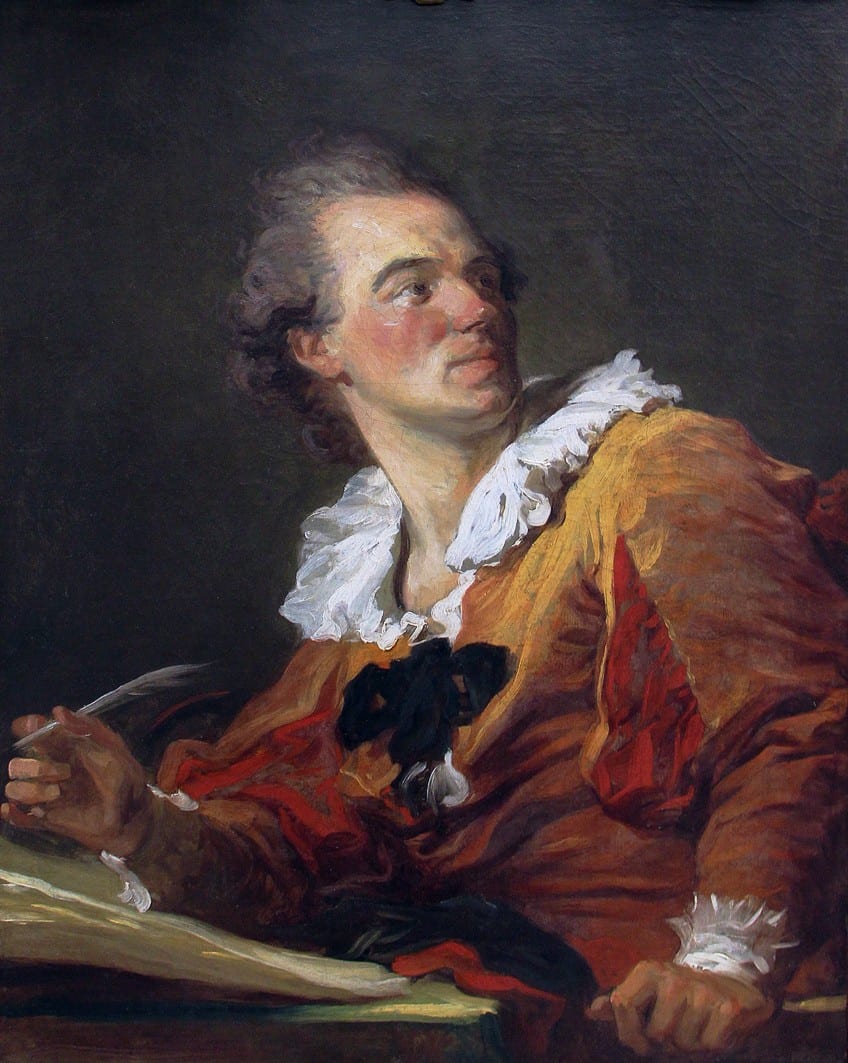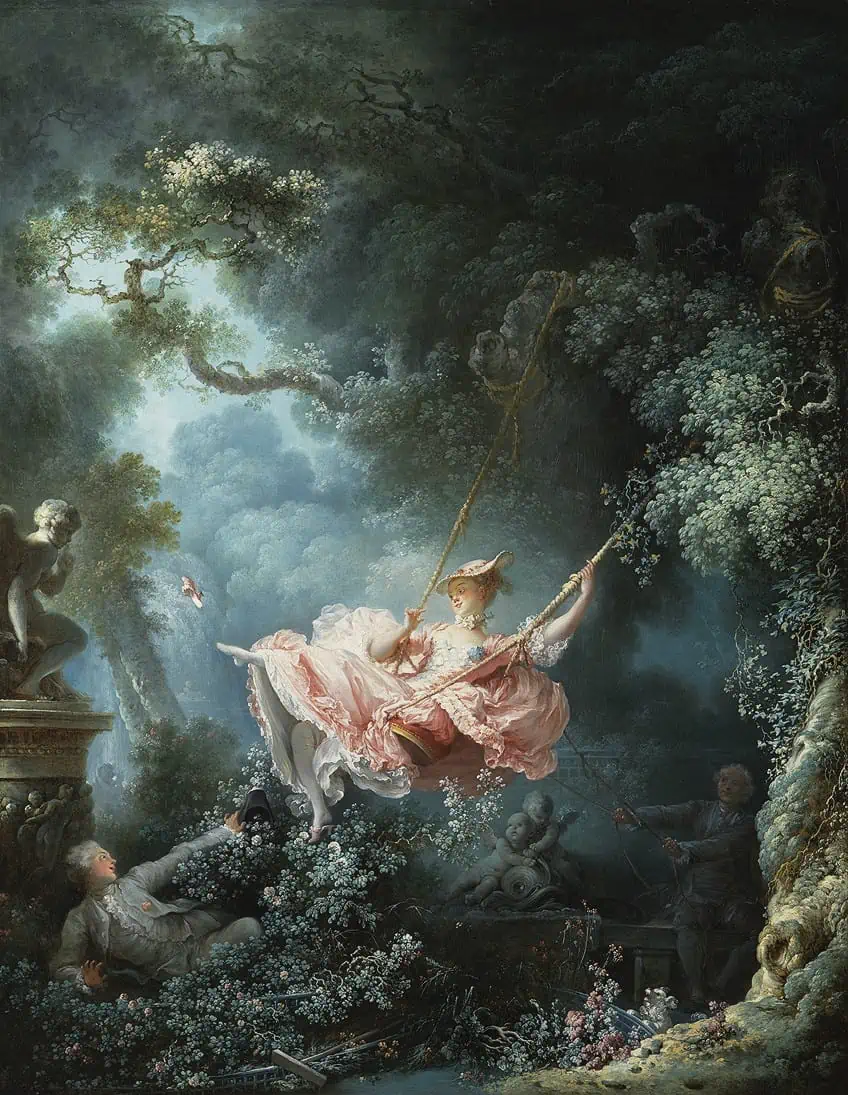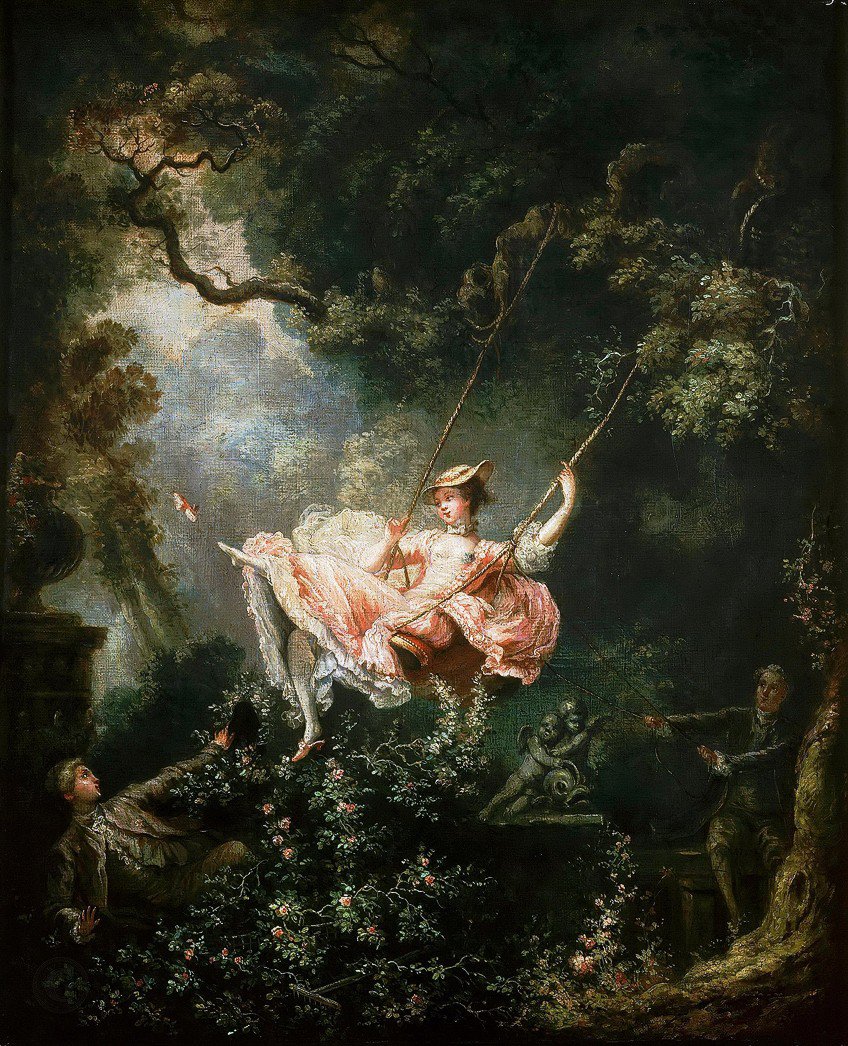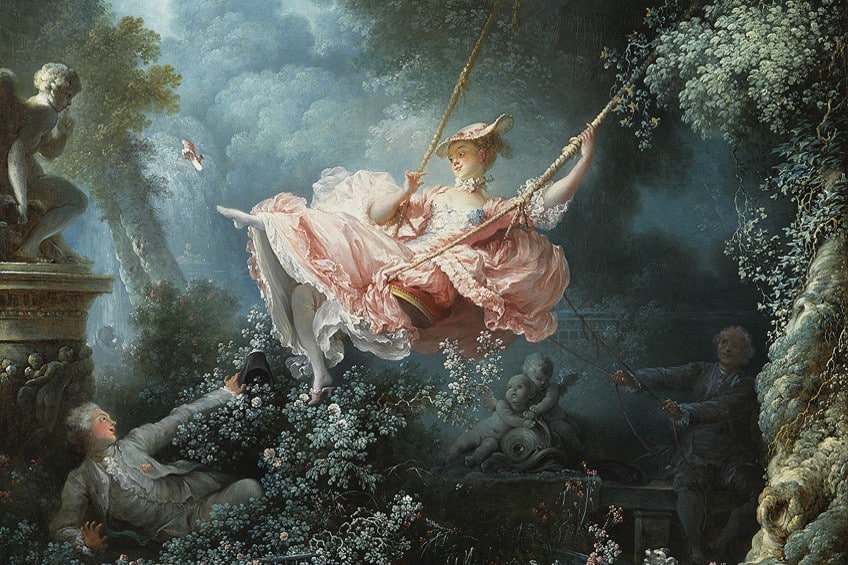“The Swing” by Jean-Honoré Fragonard – A Quick Analysis
The French Rococo artist Jean-Honoré Fragonard is regarded by many to be the most prolific painter of 18th-century France. The Swing by Jean-Honoré Fragonard is typically considered to be his most renowned work of art and features a woman on a swing. Known in French as L’Escarpolette, The Swing painting is today ranked as among the most significant Rococo artworks ever produced. To find out why this painting of a woman on a swing is so highly regarded, carry on reading more below!
Contents
The Significance of The Swing by Jean-Honoré Fragonard
| Artist | Jean-Honoré Fragonard (1732 – 1806) |
| Date Completed | c. 1768 |
| Medium | Oil on canvas |
| Dimensions (cm) | 81 x 64 |
| Location | The Wallace Collection, London, United Kingdom |
Jean-Honoré Fragonard was a highly celebrated artist who initially studied under renowned artists such as Francois Boucher and Jean Chardin and was influenced by the works of artists such as Nicolas Poussin and Giambattista Tiepolo. He enrolled at Élèves Protégés after winning the Rome de Prix in 1752, after which he enrolled at Rome’s French Academy. Fragonard started to specialize in the humorous, sensual compositions for which he is now best known in the mid-1760s.
The artist’s exquisite 18th-century color palette, funny narratives, and swift brushwork created an enchanting feeling of joy and pleasure in his works.
He then returned to France and grew in popularity due to his work with decorative schemes. He created in excess of 550 artworks in his lifetime, the most renowned of which are genre paintings that portray a feeling of intimacy and disguised sexuality. The prevailing French culture had a strong influence on the artist’s themes, which were generally sexual love scenes created for the benefit of Louis XV’s pleasure-loving court. Madame du Barry, Louis XV’s mistress, commissioned Fragonard to produce the Progress of Love in 1771, which brought him significant public recognition.

He traveled to Italy once again in 1773 and produced various works portraying portraits, landscapes, and everyday life scenes, yet his works were growing increasingly Neo-classical in style by sometime in the mid-1780s. However, The Swing by Jean-Honoré Fragonard is a representation of the work he produced while involved in the Rococo movement.
The Rococo style emerged in France during Louis XV’s reign in the early 18th century in opposition to the more traditional and geometric forms popular at the time. It quickly spread throughout Europe, namely to Bavaria, northern Italy, Austria, regions of Germany, and even Russia.
It influenced other arts as well, notably furniture, sculpture, glassware, silverware, painting, music, and drama. This sensual masterwork of Rococo painting recalling the spirit of aristocratic excess and artistic refinement on the brink of the French Revolution – demonstrates that Fragonard is absolutely unrivaled in the field of titillation. This “frivolous” style rapidly became the focus of the Enlightenment thinkers, who sought a more solemn art that demonstrated man’s nobility.
Analysis
It is believed that Baron de Saint-Julien originally commissioned this famous Rococo painting. He wanted a portrait of his mistress on a swing pulled by a bishop, while Baron de Saint-Julien was positioned so that he could look up the woman’s skirt. However, the artist decided to substitute the figure of the bishop for a meek husband. The artwork focuses on the woman on a swing, but one can see the Baron emerging from the foliage he is concealed in, peeking up at the woman’s skirt.
The woman on a swing is being pushed by her older husband in the background who seems completely unaware of the man in the bushes. At first, the artwork seems to be an ordinary depiction of an innocent woman playing on a swing, but upon closer inspection, it becomes evident that the artwork is intentionally provocative.

When the woman’s swing ascends higher, she permits the young man to look up her dress. There are several aspects of this artwork that have been added for the sake of symbolism, such as a lapdog that can be seen barking and trying to alert the husband of the young man. These dogs are believed to be symbols of faithfulness. Cupid can be seen to the left of the canvas, telling the two Venus-putti to not say anything about what is going on by putting his finger to his lips. A putto is a being that is often portrayed as a chubby masculine youngster who is nude and occasionally winged. Originally representing earthly desires, the putto grew to symbolize the sacred cherub.
They grew to signify God’s omnipresence in Baroque art. The painting’s exuberant vibrancy is enhanced by the way the dress’s frills mimic the patterns of the surrounding greenery, in addition to its warm pastel colors and gentle lighting.
Underlying Themes
Power, wealth, and sex were the three fundamental desires in France throughout the 18th-century Rococo period. For a person to be regarded as successful in that day and age, they had to be wealthy, powerful, and gorgeous. It was a time when being humble and modest were shamelessly discarded in favor of a lavish world filled with material conveniences and loose values. The Swing painting is brimming with seductive possibilities, many of which are made possible by wealth.
Fashionable attire, private amusements, stylish lifestyles, romantic experiences, and financial freedom are all examples of these exclusive possibilities that were afforded to the upper echelons of French society. This painting of a woman on a swing depicts all of these possibilities.
For example, the woman and two men are dressed in the latest fashion styles of the time. They are stress-free, laughing, and joyful while spending typically crucial working hours outdoors in pursuit of leisurely activities. The elderly husband pushing the swing is said to be a representation of money. He is well-dressed and stares at the woman affectionately. It is obviously because of his great wealth that he has managed to marry the woman on the swing. The rope that he uses to pull the swing back further symbolizes the ties that bond the two in marriage.

The beautifully dressed young woman is the main focus of the painting. She is said to represent power as her beauty has afforded her a marriage where she can wear expensive clothing and enjoy lazy leisurely activities. She also represents the power of one person to deceive another. She additionally has the power to manipulate her husband’s ignorance and to enchant the young man hiding in the bush. This man, on the other hand, is young and virile, representing lust and sex.
In this manner, the artist was able to add all three prominent themes of the age – wealth, power, and sex, into one single captivating painting.
Restoration
The artwork was re-exhibited in 2021 following a comprehensive restoration. For the first time, The Swing painting was subjected to extensive conservation and technical examination during that summer and it was subsequently mounted among the Wallace Collection’s other Fragonard paintings. The Wallace Collection is considered to be one of the most important cultural institutions in the United Kingdom since it houses notable examples of decorative and fine art on a permanent basis. The former Head of Conservation at the National Gallery, Martin Wyld, who used to repair masterpieces by painters such as Velazquez and Da Vinci, oversaw the restoration process.
The Swing painting now shimmers in a new light since the yellow varnish that concealed the artwork has been removed.

The composition’s depth has been drastically restored, as have the background elements and the texture of the paint surface. Basic underdrawings or preliminary sketches were discovered, revealing that the artist worked directly on the canvas. The Wallace Collection presented a unique program of events to coincide with the exhibition that centered on The Swing painting, the artist, and the French Rococo era.
The Importance and Legacy of The Swing by Jean-Honoré Fragonard
This work of art is widely acknowledged for its creative and cultural value, and it has left an indelible mark in the art world. The Swing painting influenced art styles and artists significantly over the years. Numerous artists have been influenced by its amusing and sensual themes, and the aesthetic has been replicated and modified in many different ways.
The artwork also portrays the extravagant and aristocratic lifestyle of French nobility in the 18th century, with its secret affairs and quest for pleasure, providing a look into the cultural and social views of the period. It is regarded as a masterwork of the Rococo movement, which was distinguished by its focus on elegance and playfulness.

It represents a time of sensuality and flirting, enjoying the delights of love and romance, and reflects the preoccupation with beauty, love, and extravagance that characterized the Rococo era. The painting of a woman on a swing showcases Fragonard’s skills as a painter. The composition is intricate, with finely portrayed humans and flora, and the use of light and shadow, as well as the meticulous details, demonstrates his technical mastery. It is an iconic image that many people recognize, even those who are unfamiliar with art history, and has been referenced in popular culture throughout the ages.
The Swing by Jean-Honoré Fragonard, also known as L’Escarpolette, is an important piece of art that reflects the atmosphere of the Rococo period, while simultaneously offering insight into France’s artistic and social environment during the 18th century. The aristocracy of this era was preoccupied with pursuing leisurely activities and amorous encounters, and this artwork perfectly embodies this. We can see a woman on a swing, flirtatiously lifting her legs as the swing ascends, much to the pleasure of a younger gentleman to the left. Her husband, though, seems oblivious as to what is going on. These three individuals represent the various aspects that were regarded as important in France in the 18th century – wealth, power, and sex.
Take a look at our Swing painting webstory here!
Frequently Asked Questions
What Is Rococo Art?
Rococo art is a style of painting that arose in the early to mid-18th century, especially in France, but subsequently expanded to other regions of Europe. It is often regarded as a response to the much more traditional and extravagant Baroque style that came before it. This period’s artists used ornate, bending shapes, complex designs, and delicate nuances in their works of art. Nature-inspired elements, such as flowers, lush vegetation, and seashells frequently appeared in Rococo artworks. Many Rococo paintings displayed love, passion, and playful situations. These subjects were portrayed in a positive and often slightly sensual manner, mirroring the era’s hedonistic tendencies.
What Is The Swing Painting About?
This famous painting of a woman on a swing was produced by the famous 18th-century French artist, Jean-Honoré Fragonard. As was typical of Rococo artworks of the time, it features people engaged in leisurely activities, such as playing on a swing. This particular work has a naughty aspect to it, as the higher the husband swings the woman, the more a man hiding in the bushes can look up her skirt.
Jordan Anthony is a Cape Town-based film photographer, curator, and arts writer. She holds a Bachelor of Art in Fine Arts from the University of the Witwatersrand, Johannesburg, where she explored themes like healing, identity, dreams, and intuitive creation in her Contemporary art practice. Jordan has collaborated with various local art institutions, including the KZNSA Gallery in Durban, the Turbine Art Fair, and the Wits Art Museum. Her photography focuses on abstract color manipulations, portraiture, candid shots, and urban landscapes. She’s intrigued by philosophy, memory, and esotericism, drawing inspiration from Surrealism, Fluxus, and ancient civilizations, as well as childhood influences and found objects. Jordan is working for artfilemagazine since 2022 and writes blog posts about art history and photography.
Learn more about Jordan Anthony and about us.
Cite this Article
Jordan, Anthony, ““The Swing” by Jean-Honoré Fragonard – A Quick Analysis.” artfilemagazine – Your Online Art Source. September 13, 2023. URL: https://artfilemagazine.com/the-swing-by-jean-honore-fragonard/
Anthony, J. (2023, 13 September). “The Swing” by Jean-Honoré Fragonard – A Quick Analysis. artfilemagazine – Your Online Art Source. https://artfilemagazine.com/the-swing-by-jean-honore-fragonard/
Anthony, Jordan. ““The Swing” by Jean-Honoré Fragonard – A Quick Analysis.” artfilemagazine – Your Online Art Source, September 13, 2023. https://artfilemagazine.com/the-swing-by-jean-honore-fragonard/.



